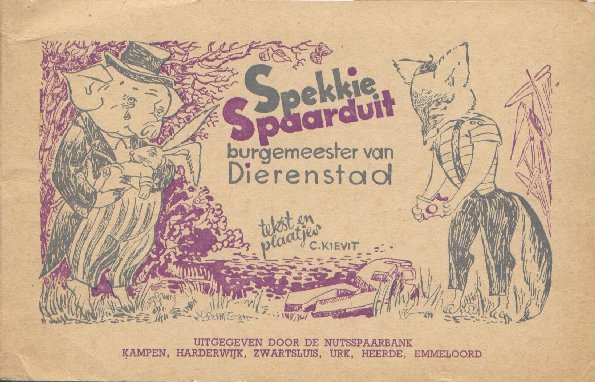
Spekkie Spaarduit teaches children to save
The bank was traditionally an institution for the older generations. This gradually started to change in the 20th century. As children’s piggybanks began to overflow, it was time to persuade them to deposit their precious pennies with the Nutsspaarbank.



With this in mind, a Spaarbank union was established in 1907 to encourage youngsters to open an account for themselves. The easiest way to reach children was through the schools, so the union sought publicity among teachers. Unfortunately, this didn’t work.
From 1930 onwards, the union changed its tactics and took a more direct approach to its young target group. They instigated youth savings banks, which certainly attracted younger clients. But they also needed to hang on to them. So they developed some special propaganda material.
Spekkie as a mascot
1931 saw the first edition of the magazine De gelukscent. Young members of the Spaarbankbond were sent a birthday card and loyal savers were given rewards. But this was not all. Young savers were also given their very own mascot: Spekkie Spaarduit – in the shape of a traditional piggybank.
Fifteen years later, during World Savings Day on 31 October 1946, young account-holders were handed the comic Spekkie Spaarduit, and the union organised numerous activities for the youth. Children who saved were hot property in those days. Adults thought that the country would only recover from the post-war malaise if young people were encouraged to invest in a new future. This resulted in the foundation in 1948 of the Saving Propaganda Foundation, which would continue its work for the next 47 years.
Spekkie Spaarduit, Mayor of Animal City
Spekkie Spaarduit was the pig-hero in five comic books published between 1950 and 1952. He was the Mayor of Animal City, and every story had a clear moral undertone concerning saving. In the first volume, Spekkie Spaarduit, burgemeester van Dierenstad, the message was that dreaming of progress is good, but that you must also be well-prepared and able to take care of yourself. In the comic book adventure, all the residents of the forest believed the words of the fox ‘Professor Esopias’, who promised to chase away the winter with a rocket. Even the wise owl (who couldn’t read and so wasn’t really wise) and Jules the historian (a donkey) thought that the fox was about to go down in history. They made fun of Spekkie Spaarduit, who was trying to persuade the animals to stock up on food for the winter, as he did every year in early October. But our hero wasn’t put off and he and his friend Oebel the Bear gathered and stored enough winter food for the entire forest, just in case the plans with the rocket misfired (literally or metaphorically).
Help for the bees
In the second volume, Spekkie Spaarduit vraagt hulp voor de bijen, a storm has destroyed the hollow tree trunk that the bees lived in. Nobody was willing to help them find a new home, because all the animals had been affected one way or another. Luckily, the bees were avid savers and they used their stocks of honey to persuade Oebel the Bear and his friends to hollow out a new home for them. The moral of this story was plain for all to see: only people who save have something to fall back on when times get hard.
Maartje Blackbird’s balcony
The third volume was called Spekkie Spaarduit en het balkon van Maartje Merel and this time, the message was blatantly capitalist. Maartje Merel (a blackbird) wanted to build a balcony on her nest, so she instructed her mate to start saving. He wasn’t interested in her plan, so Maartje set to work herself, leaving her mate to look after the children. Before long, the mate couldn’t wait to start saving. They used the nuts they saved to ‘pay’ a carpenter, Eko the squirrel. Suddenly, all the other birds wanted a balcony too. They all started saving and the carpenter had more work than he could handle. He quickly took on staff to help, and hey presto – economic growth!
The big piggybank
Spekkie Spaarduit en het grote spaarvarken was all about stockpiling to help animals in need. This volume reflected the philanthropic side of the Nuts savings banks. The pig turned out to be a solid brand, and he often appeared in other publications. A school savings club was named after him (the Spekkie Spaarduit Club) and he featured in a pedagogical booklet entitled Jos Slordevos. The books had a dual purpose: they also served as colouring books for the children.
Well-known writers and illustrators
The Saving Propaganda Foundation managed to persuade well-known writers and illustrators to help create the booklets. De Spekkie Spaarduit Club, for example, was the work of the revered writer and illustrator Rie Cramer. Three of the other booklets were written by the equally famous author A.D. Hildebrand, author of radio plays and children’s books. The illustrations in his Spekkie booklets were created by the Rotterdam painter and illustrator Charles Jean Kemper, well-known for his urban landscapes.